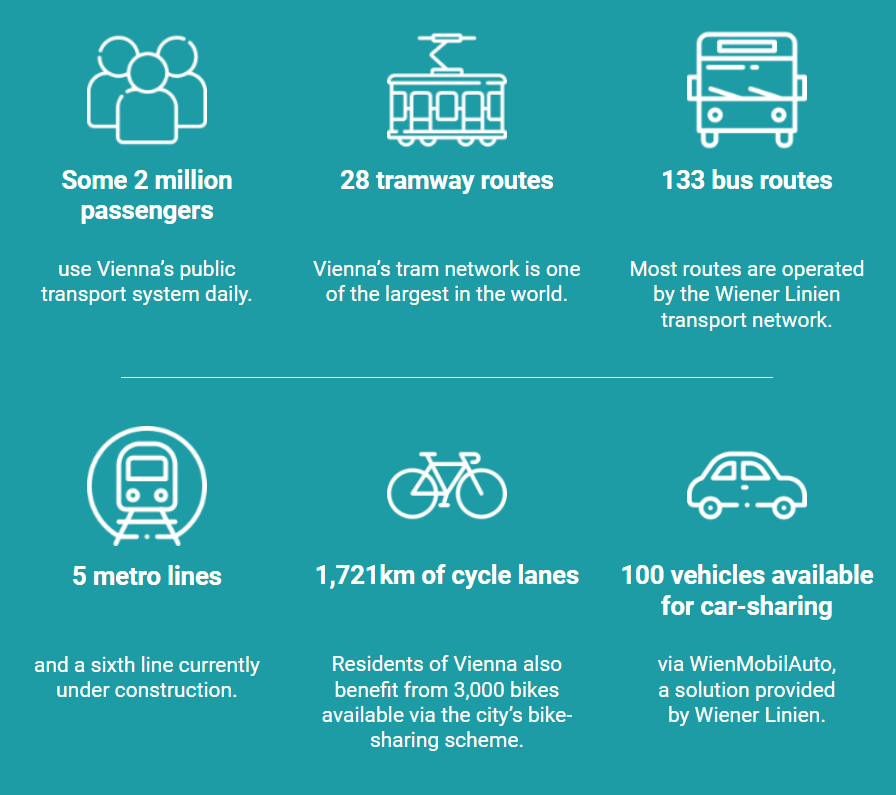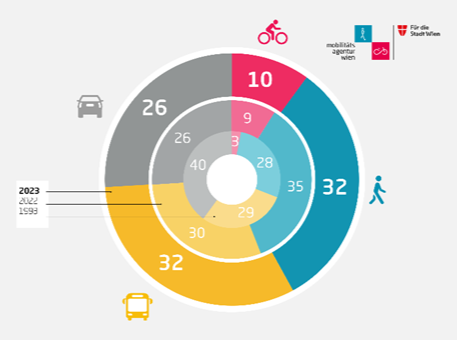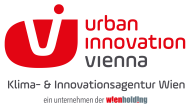Vienna, a city steeped in tradition is well-known for being a great place to live – and is also on the cutting edge when it comes to sustainable mobility. Major renovation of public transport over the past few decades, encouraging walking and cycling and investments to provide an innovative offering have all contributed to a mobility system geared to the future. The goal over the coming years is to go even further and make the city climate-neutral by 2040.
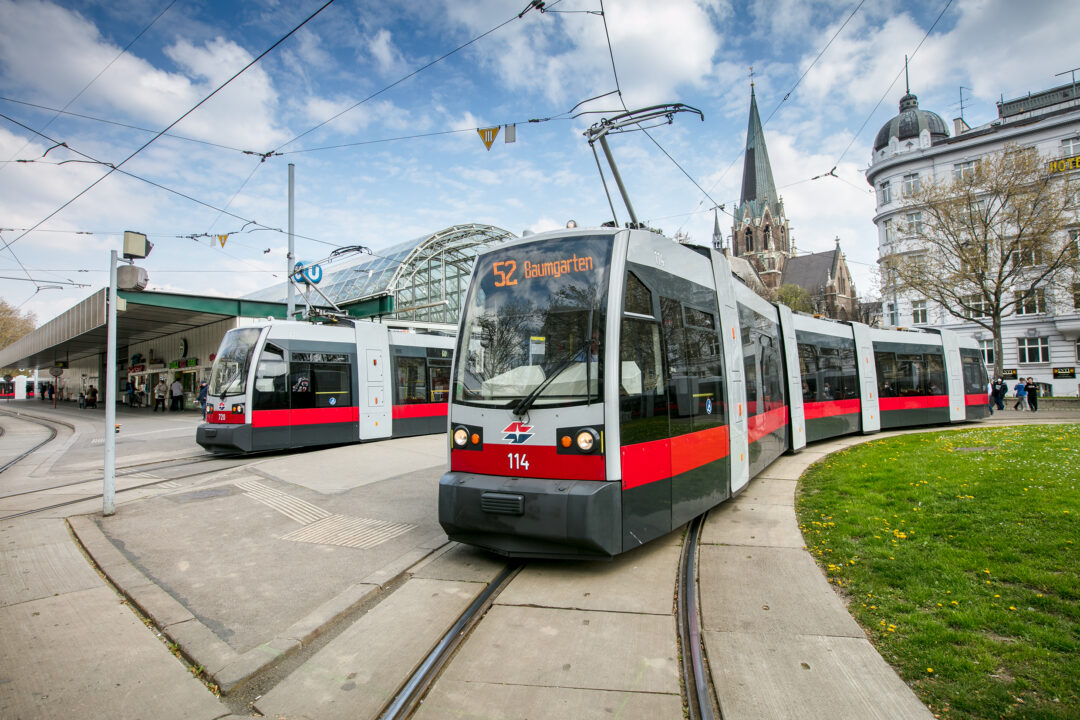
Travel habits in Vienna: towards sustainable mobility
As Vienna’s annual transport survey shows, 42% of all journeys are by bike or on foot, while a further 32% use public transport. The special focus on sustainable means of transport is tangible on a day-to-day level, with a rise in the number of journeys on foot and by bike for travel to and from work and shopping.
The proportion of bike journeys rose from 7% to 9% in 2020, a trend that continued in 2022 in the wake of the Covid pandemic. Public transport continues to account for a third of all journeys. Walking increased significantly in 2020, rising to 37%. This trend also continued in 2021 and 2022 (35%) with a slight decline in 2023 (32%). Still, local residents have now got into the habit of walking to destinations close to home and as a leisure activity.
While many cities have seen a return to car use since Covid, Vienna has risen to the challenge of sustainable mobility. Car journeys have levelled off at 26%, a relatively low figure.
Public transport: fast, attractive, and affordable
- Metro: The underground network is extensive, with five lines connecting different city districts and modern and frequent trains. Two lines are currently being extended to make high-quality public transport available to a still larger share of the population.
- Trams: Vienna is well known for its huge tram network. Besides being a practical means of transport, trams are a great way of getting to know the city.
- Buses: The bus network supplements the metro and tram network, serving areas further away from the city centre.
Vienna’s public transport system is also notable for its fare structure. Since 2012, an annual season ticket allows passengers to travel on the entire network as much as they please for €1 per day.
Public transport accessibility
Vienna places a special emphasis on accessibility to its public transport. Metro stations and trams are designed to be easily accessible, and broader measures have also been implemented to facilitate travel for mobility-impaired individuals.
Vienna: a cycle-friendly city
Vienna is actively engaged in promoting cycling, extending cycle tracks and creating cycleways. The cycling network (including mountain bike trails) currently totals 1,721km and is constantly being extended. The city also has a huge bike-sharing network, with a total of 3,000 bikes available for hire at competitive prices.
Facilitating pedestrian traffic
Getting around Vienna on foot is very popular, and indeed forms part of the city’s identity. Neighbourhood centres and the city centre itself devote plenty of space to pedestrians, with wide pavements, pedestrian areas and countless squares to enjoy. The underlying planning has created a dynamic atmosphere that nurtures environmentally-friendly mobility. Pedestrian traffic master plans have been drawn up to define goals and practical measures for each district.
Electric mobility: a future with zero local emissions
Electric vehicles are becoming increasingly common on the streets of Vienna. The city has ramped up the deployment of charging stations and is encouraging people to shift to eco-friendly cars. Vienna’s public charging infrastructure alone totals 1,000 charging stations plus two fast charging hubs. The city is coordinating the rollout of the charging infrastructure required to address the rise of electric mobility and achieve the ‘climate neutral’ target set for 2040.
Innovative mobility solutions
Car-sharing schemes are widely used in Vienna, offering residents a flexible alternative to owning their own car. Wiener Linien’s WienMobil Auto car-sharing scheme has a total of 100 vehicles available for rent at affordable rates throughout the city, helping to reduce traffic and alleviating the pressure on parking spaces.
Smart traffic management and digitalisation
Vienna is increasingly turning to smart traffic management systems and new technology to keep the city moving. Examples include adaptive traffic lights, traffic management systems, and the inclusion of real-time information in public transport to reduce congestion and improve overall efficiency.
Innovation & research
The city is investing in research and innovation in the field of mobility. Examples include pilot projects for self-driving vehicles, the development of applications to integrate different modes of transport, and research into new technologies that could improve transportation efficiency.
Sustainable mobility in Vienna: key figures
